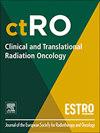Reirradiation clinical practice in gastrointestinal abdominal malignancies: an international reirradiation collaborative group (ReCOG) systematic review
IF 2.7
3区 医学
Q3 ONCOLOGY
引用次数: 0
Abstract
Purpose
Reirradiation in abdominal malignancies has grown more common with advanced radiotherapy techniques. However, clinical use and implementation varies, and there remains limited consensus on best practices for reirradiation. In this systematic review, a multidisciplinary team treating gastrointestinal and hepatobiliary malignancies within the Reirradiation Collaborative Group (ReCOG) convened to review published literature on reirradiation in the abdomen to offer insights into patient selection, radiotherapy planning, risk management, and assessing knowledge gaps for future development of guidelines.
Methods and Materials
A systematic search of Cochrane Central, CINAHL Plus, EMBASE, and PubMed up to August 30, 2024, was conducted as per Preferred Reporting Items for Systematic reviews and Meta-Analyses (PRISMA) framework. Data on patient characteristics, radiation doses, dose constraints, treatment outcomes, and toxicities were extracted. Where feasible, pooled weighted analyses were performed.
Results
Thirty-three studies involving 1,264 patients met inclusion criteria: 30 were retrospective and 3 prospective. The median number of patients reported per study was 26 (range 2–245). Of the reported tumor sites, 718 patients had liver tumors and 277 pancreas, with smaller numbers of mixed/lymph node targets. Reirradiation doses, fractionation schemes, and dose constraints varied widely; only half of the studies provided explicit organ-at-risk constraints. Three studies included patients treated with palliative intent. Median overall survival ranged from 5.9 to 44 months, with a pooled weighted median OS of 19.6 months across 20 studies that reported it. One-year local control rates ranged from 19 % to 93 %, with severe (grade ≥ 3) toxicities typically reported in 5–15 % of patients, although one study reported 25 % lethal RILD in liver reirradiation.
Conclusion
Reirradiation in abdominal malignancies appears to be able to achieve meaningful local control and survival in select patients, though heterogeneity in planning, dosing, and toxicity reporting remains a major challenge for establishing best practices. Standardized reporting of doses, constraints, and dose-volume relationships are needed to guide safe and effective reirradiation in this setting.
再放射治疗胃肠道腹部恶性肿瘤的临床实践:国际再放射协议组(ReCOG)系统评价
目的随着先进的放射治疗技术的发展,腹部恶性肿瘤的放射治疗越来越普遍。然而,临床使用和实施各不相同,对再照射的最佳做法仍有有限的共识。在这篇系统综述中,一个治疗胃肠道和肝胆恶性肿瘤的多学科小组在再照射协作组(ReCOG)召集,回顾了已发表的关于腹部再照射的文献,以提供对患者选择、放疗计划、风险管理和评估知识差距的见解,为未来指南的制定提供参考。方法和材料根据系统评价和荟萃分析(PRISMA)框架的首选报告项目,对截至2024年8月30日的Cochrane Central、CINAHL Plus、EMBASE和PubMed进行了系统检索。提取了患者特征、辐射剂量、剂量限制、治疗结果和毒性的数据。在可行的情况下,进行合并加权分析。结果33项研究纳入1264例患者,其中30项为回顾性研究,3项为前瞻性研究。每项研究报告的患者中位数为26例(范围2-245例)。在报告的肿瘤部位中,718例患者有肝脏肿瘤,277例患者有胰腺肿瘤,混合/淋巴结靶点较少。再照射剂量、分离方案和剂量限制差别很大;只有一半的研究提供了明确的器官风险限制。三项研究纳入了以姑息治疗为目的的患者。中位总生存期从5.9个月到44个月不等,在20项研究中,合并加权中位总生存期为19.6个月。一年的局部控制率从19%到93%不等,通常有5 - 15%的患者报告了严重(≥3级)毒性,尽管一项研究报告了25%的肝脏再照射致死性RILD。结论:腹部恶性肿瘤的再放射治疗似乎能够在选定的患者中实现有意义的局部控制和生存,尽管计划、剂量和毒性报告的异质性仍然是建立最佳实践的主要挑战。需要对剂量、限制和剂量-体积关系进行标准化报告,以指导在这种情况下安全有效的再照射。
本文章由计算机程序翻译,如有差异,请以英文原文为准。
求助全文
约1分钟内获得全文
求助全文
来源期刊

Clinical and Translational Radiation Oncology
Medicine-Radiology, Nuclear Medicine and Imaging
CiteScore
5.30
自引率
3.20%
发文量
114
审稿时长
40 days
 求助内容:
求助内容: 应助结果提醒方式:
应助结果提醒方式:


